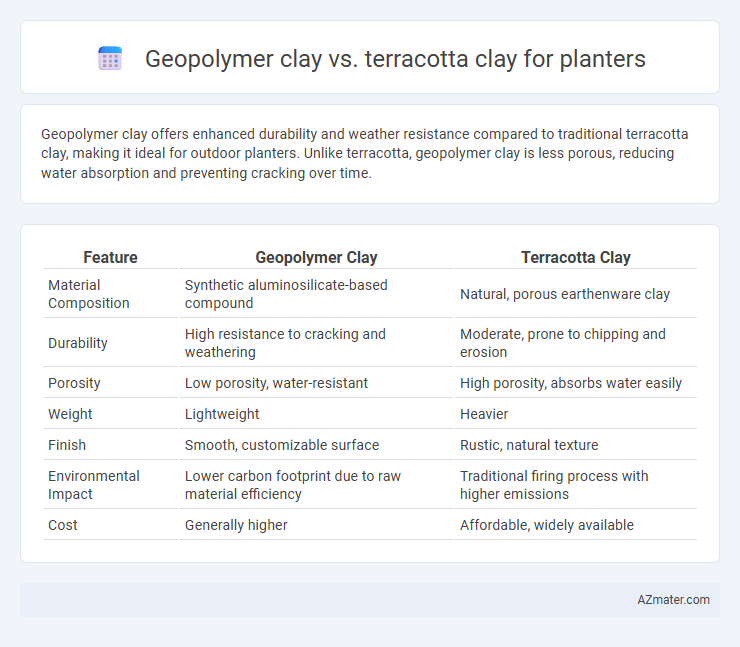Geopolymer clay offers enhanced durability and weather resistance compared to traditional terracotta clay, making it ideal for outdoor planters. Unlike terracotta, geopolymer clay is less porous, reducing water absorption and preventing cracking over time.
Table of Comparison
| Feature | Geopolymer Clay | Terracotta Clay |
|---|---|---|
| Material Composition | Synthetic aluminosilicate-based compound | Natural, porous earthenware clay |
| Durability | High resistance to cracking and weathering | Moderate, prone to chipping and erosion |
| Porosity | Low porosity, water-resistant | High porosity, absorbs water easily |
| Weight | Lightweight | Heavier |
| Finish | Smooth, customizable surface | Rustic, natural texture |
| Environmental Impact | Lower carbon footprint due to raw material efficiency | Traditional firing process with higher emissions |
| Cost | Generally higher | Affordable, widely available |
Introduction to Geopolymer and Terracotta Clays
Geopolymer clay is an innovative, eco-friendly material made from aluminosilicate-rich industrial byproducts like fly ash or metakaolin, offering high durability and resistance to weather elements ideal for planter construction. Terracotta clay, derived from natural iron-rich clay fired at lower temperatures, provides a traditional porous texture that enhances plant aeration and water drainage but is more fragile and susceptible to chipping. Understanding these fundamental differences aids in selecting the appropriate clay type based on planter longevity, environmental impact, and functional performance.
Composition and Material Properties
Geopolymer clay consists of an aluminosilicate-based inorganic polymer, offering high mechanical strength, enhanced durability, and resistance to chemical degradation compared to traditional terracotta clay, which is primarily composed of natural clay minerals like kaolinite and illite. Terracotta clay exhibits excellent porosity and breathability, which promotes plant root aeration but is more susceptible to cracking and water absorption under freeze-thaw conditions. Geopolymer clay's low porosity and superior thermal stability make it ideal for long-lasting planters that require minimal maintenance and enhanced structural integrity.
Environmental Impact and Sustainability
Geopolymer clay offers a significantly lower environmental impact compared to terracotta clay due to its use of industrial by-products such as fly ash and slag, reducing the need for traditional clay extraction and minimizing carbon emissions during production. Terracotta clay, while biodegradable and sourced naturally, requires high-temperature kiln firing, leading to substantial energy consumption and CO2 emissions. Choosing geopolymer clay for planters supports sustainable manufacturing practices by conserving natural resources and lowering the overall carbon footprint.
Durability and Longevity of Planters
Geopolymer clay planters demonstrate superior durability compared to traditional terracotta clay, resisting cracking and weathering more effectively due to their synthetic, cementitious composition. Terracotta clay planters, while naturally porous and breathable, tend to be more prone to chipping and degradation over time, especially in freeze-thaw cycles. The longevity of geopolymer clay planters is significantly enhanced by their resistance to moisture absorption and thermal stress, ensuring extended outdoor use without compromising structural integrity.
Water Absorption and Drainage
Geopolymer clay features significantly lower water absorption rates compared to traditional terracotta clay, enhancing its durability and resistance to moisture damage in planters. Terracotta clay typically absorbs water more readily, which can improve self-watering through evaporation but may lead to quicker deterioration and potential root rot without proper drainage design. Optimizing drainage holes in both materials is essential, but geopolymer planters offer superior water retention control and reduced risk of overwatering due to their dense, less porous structure.
Aesthetic Appeal and Finishing Options
Geopolymer clay offers a modern, smooth finish with high versatility in texture and color customization, making it ideal for sleek, contemporary planter designs. Terracotta clay provides a natural, earthy aesthetic with its characteristic warm reddish-brown hue and traditional handcrafted appearance. While geopolymer clay supports more intricate surface treatments and weather-resistant coatings, terracotta excels in rustic charm but requires sealing to enhance durability and maintain its classic matte finish.
Weight and Portability Comparison
Geopolymer clay planters are significantly lighter than terracotta clay planters due to their synthetic composition, making them easier to carry and reposition. Terracotta clay is denser and heavier, which can result in increased fragility during transport despite its traditional aesthetic. For portable gardening solutions, geopolymer clay offers enhanced durability combined with superior weight management compared to terracotta.
Cost and Market Availability
Geopolymer clay offers a cost-effective alternative with lower raw material expenses compared to traditional terracotta clay, which relies on natural clay deposits often subject to regional scarcity and price fluctuations. Market availability of geopolymer clay is expanding due to synthetic production methods, making it consistently accessible worldwide, while terracotta clay remains regionally dependent and sometimes limited by environmental regulations. The price stability of geopolymer planters appeals to budget-conscious consumers, whereas terracotta planters can vary widely in cost based on local supply and artisanal craftsmanship.
Suitability for Various Plant Types
Geopolymer clay offers excellent durability and moisture resistance, making it suitable for both indoor and outdoor planters that house a wide range of plants including succulents and tropical species. Terracotta clay, known for its porous nature, provides natural aeration and moisture regulation, ideal for drought-tolerant plants such as cacti and herbs. The choice between geopolymer and terracotta clay planters depends on the specific water retention needs and environmental conditions preferred by different plant types.
Final Verdict: Which Clay is Better for Planters?
Geopolymer clay offers superior durability and weather resistance compared to traditional terracotta clay, making it ideal for outdoor planters exposed to varying climates. Terracotta clay provides excellent breathability and natural moisture regulation, promoting healthier root systems but is more prone to cracking under freeze-thaw conditions. For long-lasting, low-maintenance planters, geopolymer clay is better suited, while terracotta remains preferred for aesthetic appeal and natural plant health benefits.

Infographic: Geopolymer clay vs Terracotta clay for Planter
 azmater.com
azmater.com